<< Previous | Displaying results 176-200 of 1298 for "nazi germany" | Next >>
Group portrait of German girls posing outside their school in front of a Nazi flag. Among those pictured is Lilli Eckstein six months before she was expelled from the school for being Jewish. Heldenbergen, Germany, 1935.

On the day of book burnings in Germany, massive crowds march from New York's Madison Square Garden to protest Nazi oppression and anti-Jewish persecution. New York City, United States, May 10, 1933.
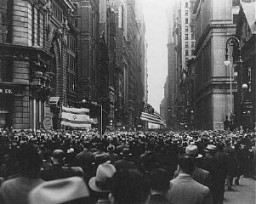
This image shows a 1935 poster by the antisemitic Der Stürmer (Attacker) newspaper. The poster justifies prohibiting “interracial” relationships between Jews and non-Jews under the Nuremberg Race Laws. Many Germans reported suspicions of the “crime” of interracial relationships to the police. The police needed the public to be their “eyes and ears” in this and other matters. Informers were variously motivated by political beliefs, personal prejudices, the desire to settle petty quarrels, or…
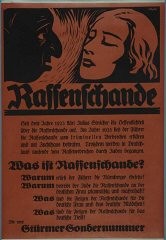
Election poster reading "The People Vote Listing One: Nationalsocialism," 1932-1933

On the night of February 27, 1933, an unemployed Dutch construction worker named Marinus van der Lubbe set fire to the Reichstag (German parliament) building, causing serious damage. The Nazis blamed the Communists for the fire and claimed emergency powers to crush all opposition. Bolstering Nazi claims, the police also arrested three Bulgarian members of the Communist International, who were in Germany at the time, and a leading German Communist. Despite Nazi claims, however, responsibility for the fire…

Portrait of Alfred Rosenberg. One of a collection of portraits included in a 1939 calendar of Nazi officials. Germany, 1939.
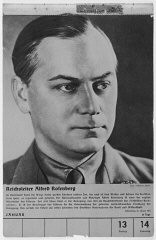
Sign used during the anti-Jewish boycott: "Help liberate Germany from Jewish capital. Don't buy in Jewish stores." Germany, 1933. (Source record ID: X89-204/08)
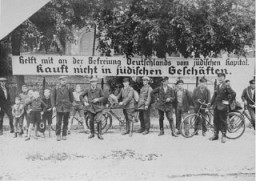
On the day of his appointment as German chancellor, Adolf Hitler greets a crowd of enthusiastic Germans from a window in the Chancellery building. Berlin, Germany, January 30, 1933.
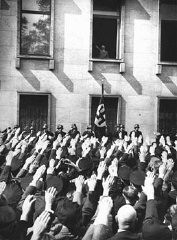
In 1945, Robert Mills Donihi was practicing law in Nashville, Tennessee. He accepted a government assignment to Tokyo where he worked on the trial of 28 high-ranking Japanese officers. After a year, he left for Germany, and arrived in Nuremberg in January 1947. Donihi was a member of the legal team at the postwar US trials in Germany, serving as both an interrogator and a prosecutor.

Fascism is a far-right authoritarian political philosophy. Learn about the history and principles of fascism and its implementation in Nazi Germany.
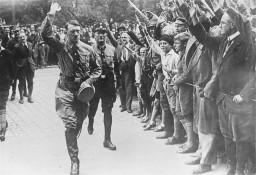
The SA established a protective custody camp at Hainewalde in March 1933. Well-known journalist and writer Axel Eggebrecht was among its early prisoners.
Article 48 allowed the German president to declare a state of emergency in times of national danger and effectively to rule as a dictator for short periods. Learn about its far-reaching effects.
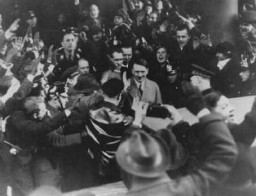
The US 8th Infantry and the 82nd Airborne Divisions arrived at the Wöbbelin camp in May 1945, witnessing the deplorable living conditions in this subcamp of the Neuengamme concentration camp.
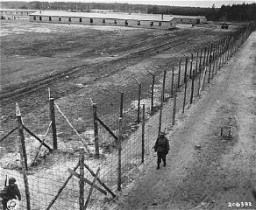
In the 25-point program, Nazi Party members publicly declared their intention to segregate Jews from "Aryan" society and to abrogate Jews' political, legal, and civil rights. Germany, 1931.
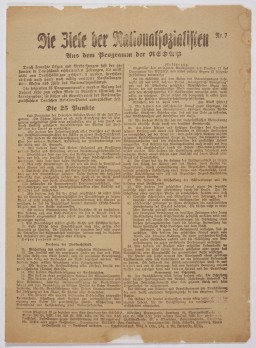
The White Rose, led by students including Hans and Sophie Scholl, was an anti-Nazi group during WWII. Its members spread leaflets denouncing the regime.
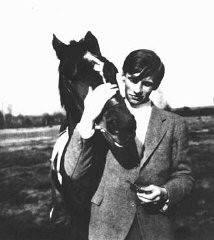
The Law against the Founding of New Parties proclaimed the Nazi Party as the only political party in Germany, which became a one-party dictatorship led by the Nazis.
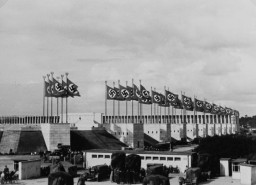
Karl Höcker created a personal album of photographs chronicling SS officers’ activities at Auschwitz. Learn about this chilling collection.
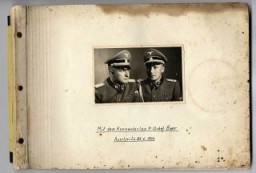
Learn about the establishment and history of the Dachau subcamp München-Schwabing, and the role of Eleonore Baur (also known as Schwester Pia or Sister Pia).
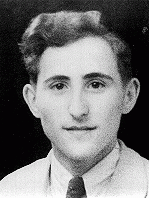
A certificate of "Aryan" descent, issued to Joseph Schäfer of Mühlheim, Germany. To prove one's "Aryan" racial status in Nazi Germany, an individual had to trace their ancestry back to 1800. Signed by an official justice of the peace, this certificate attests to Schäfer's parentage and baptism. Dated January 14, 1936.
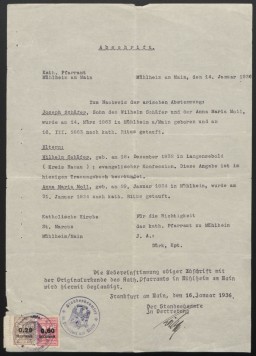
A newspaper advertisement for the Damenklub Violetta, a Berlin club frequented by lesbians, 1928. Before the Nazis came to power in 1933, lesbian communities and networks flourished in Germany.
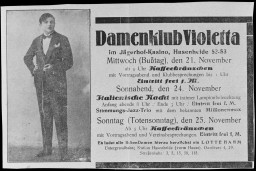
At the end of World War II, more than three-quarters of the city of Nuremberg, Germany, lay in rubble. This US Army Air Corps color footage shows some of the war damage in Nuremberg, which had been host in the 1920s and 1930s to massive and lavish rallies for the Nazi party.
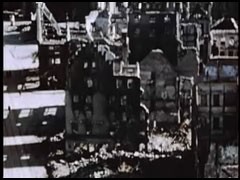
In 1933, Nazi Party leader Adolf Hitler became chancellor of Germany and quickly turned the nation's fragile democracy into a one-party dictatorship. Police rounded up thousands of political opponents, detaining them without trial in concentration camps. The Nazi regime also put into practice racial policies that aimed to "purify" and strengthen the Germanic "Aryan" population. A relentless campaign began to exclude Germany's one-half million Jews from all aspects of German life. For two weeks in August…
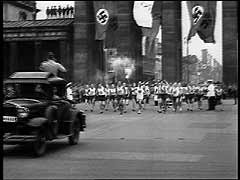
After Adolf Hitler became chancellor of Germany, he persuaded his cabinet to declare a state of emergency and end many individual freedoms. Here, police search a vehicle for arms. Berlin, Germany, February 27, 1933.
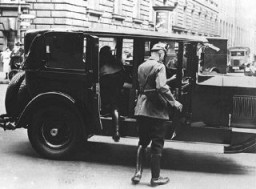
We would like to thank Crown Family Philanthropies, Abe and Ida Cooper Foundation, the Claims Conference, EVZ, and BMF for supporting the ongoing work to create content and resources for the Holocaust Encyclopedia. View the list of donor acknowledgement.